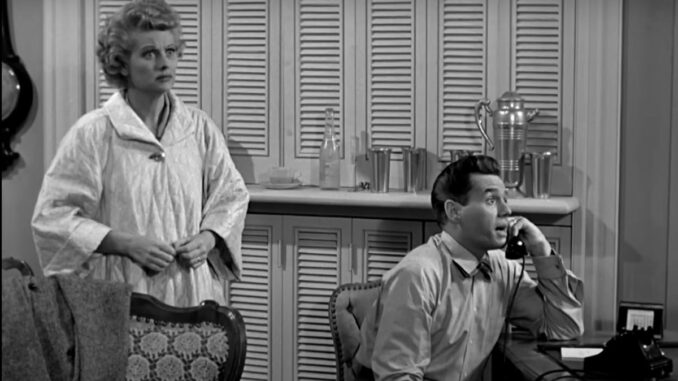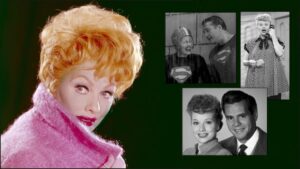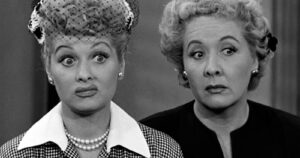
Introduction: What Made ‘I Love Lucy’ a Cultural Phenomenon?
“I Love Lucy” remains one of the most beloved and groundbreaking sitcoms of all time. Starring Lucille Ball and Desi Arnaz, this classic show redefined television comedy and became an anchor for the family sitcom genre. However, there’s more to “I Love Lucy” than slapstick humor and iconic scenes like the unforgettable chocolate factory episode. Behind the scenes, fascinating details about the show’s creation, production, and stars add layers to its story that fans can’t get enough of. Ready to dive in?
1. The Pregnancy Episode Was a Game-Changer
For the 1950s, discussing pregnancy on television was almost taboo. Yet, Lucille Ball’s real-life pregnancy was written into the show, an unprecedented move for the time. It led to an episode that remains one of the most-watched TV moments in history.
2. Desilu Productions: A Powerhouse in Television
Lucille Ball and Desi Arnaz co-owned Desilu Productions, making Ball one of the first women to run a major TV production company. This powerhouse later produced iconic shows like “Star Trek” and “Mission: Impossible,” changing television forever.
3. Lucille Ball Paved the Way for Women in Comedy

Lucille Ball’s role in “I Love Lucy” wasn’t just about her comedic talent. She pushed boundaries for women on-screen, influencing generations of female comedians and actresses. She proved that women could be leading stars in comedy, a revolutionary idea at the time.
4. The Show’s Cinematic Approach Was Unusual for Its Time
While many shows were filmed live, “I Love Lucy” was shot on film with a multi-camera setup. This allowed for higher-quality footage, which is why the show still looks great even decades later.
5. Lucy and Desi’s Chemistry Was Real and Magnetic
Their on-screen chemistry made the show a hit, and it wasn’t all acting. Lucille Ball and Desi Arnaz were married in real life, bringing authentic emotion to the roles of Lucy and Ricky Ricardo. This chemistry helped “I Love Lucy” stand out from other sitcoms of its era.
6. The Iconic Chocolate Factory Episode Was Almost Too Much to Handle
The “Job Switching” episode, where Lucy and Ethel work at a chocolate factory, is one of the series’ most famous scenes. However, it was so intense that both Ball and co-star Vivian Vance struggled to keep up with the pace, leading to real moments of hilarity and chaos on screen.
7. Vivian Vance Was Not Exactly Ethel’s Age

Vivian Vance, who played Lucy’s best friend, Ethel Mertz, was actually much younger than her character. Despite this, her portrayal was so convincing that audiences still remember her as the lovable, slightly older friend and neighbor.
8. Lucille Ball’s Hair Was a Carefully Guarded Secret
Lucy’s fiery red hair became her signature look, but it wasn’t natural. The bright red color was achieved through henna, a fact that was considered a bit of a mystery at the time. Her unique look helped her stand out, adding to her iconic status.
9. The Show Was the First to Use a Live Studio Audience
“I Love Lucy” was groundbreaking in using a live studio audience during filming. This allowed actors to perform for a crowd, bringing a level of spontaneity and energy that only comes from real-time feedback.
10. Desi’s Accent Was Initially a Concern for Producers
Desi Arnaz’s Cuban accent worried producers who thought audiences might struggle to understand him. However, his charm won over audiences, and his accent became an endearing feature of his character, Ricky Ricardo.
11. Desilu Innovations Brought Syndication to Television
Desi Arnaz spearheaded the idea of syndicating “I Love Lucy,” ensuring that the show’s episodes could continue airing long after production ended. This practice has since become a television staple and allows fans to enjoy shows long after their initial run.
12. The Show Had Realistic Marriage Conflicts
“I Love Lucy” depicted genuine marital disagreements between Lucy and Ricky. Their squabbles and resolutions were relatable and showcased realistic dynamics, making them more than just a comedic duo.
13. Lucy Had to Hide Her Natural Brunette Hair
Despite becoming famous as a redhead, Lucille Ball was naturally a brunette. Her trademark red locks were part of her transformation into the character of Lucy Ricardo, and the look became iconic.
14. It Paved the Way for On-Screen Representation of Multicultural Couples
Lucy and Ricky’s marriage was one of the first examples of a mixed-race couple on American television, helping to break down racial stereotypes and present a positive, loving relationship to a broad audience.
15. The Show’s Ratings Were Unbeatable
“I Love Lucy” became so popular that it’s one of the few shows to rank number one in the Nielsen ratings every season it aired. Few shows have achieved that level of success, proving its lasting appeal and impact.
Conclusion: A Legacy That Still Sparkles
“I Love Lucy” changed the television landscape and continues to entertain viewers across generations. The show’s legacy lives on through reruns, inspiring sitcoms, and Lucille Ball’s enduring influence on comedy. From groundbreaking representation to comedic genius, the show’s trivia only deepens the appreciation for what Lucy and Ricky brought to millions of living rooms worldwide.
FAQs
- What made ‘I Love Lucy’ groundbreaking?
Its approach to filming, live studio audience, and tackling real-life issues made it unique for its time. - Was Lucille Ball’s red hair natural?
No, she was a natural brunette who dyed her hair red for her role. - Did Lucille Ball and Desi Arnaz stay married?
No, they divorced in 1960 but remained friends and business partners. - Why is the chocolate factory episode so famous?
Its hilarious, fast-paced scenes perfectly captured Lucy and Ethel’s comedic timing and became an iconic TV moment. -
Did ‘I Love Lucy’ influence other sitcoms?
Absolutely, it set a standard in comedy, filming style, and character development that inspired countless shows that followed.
